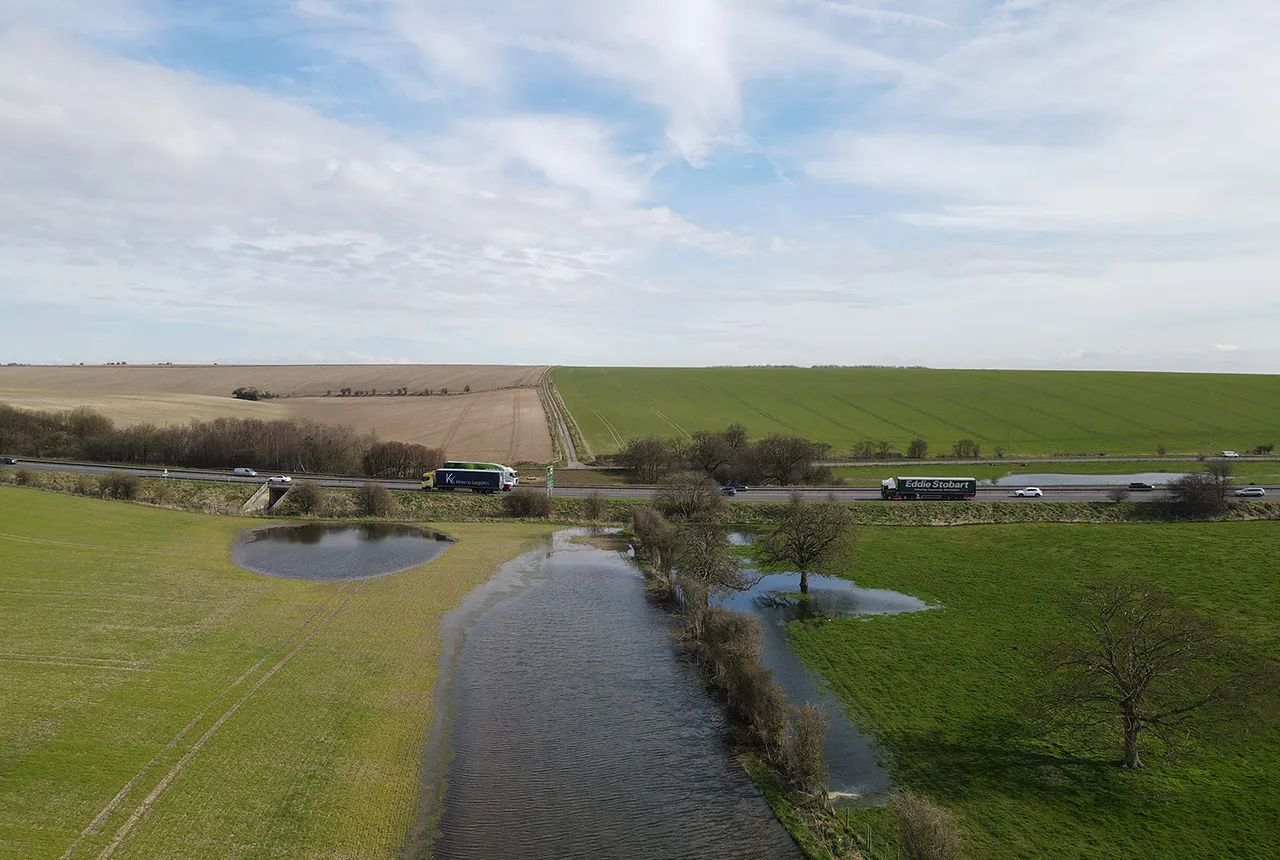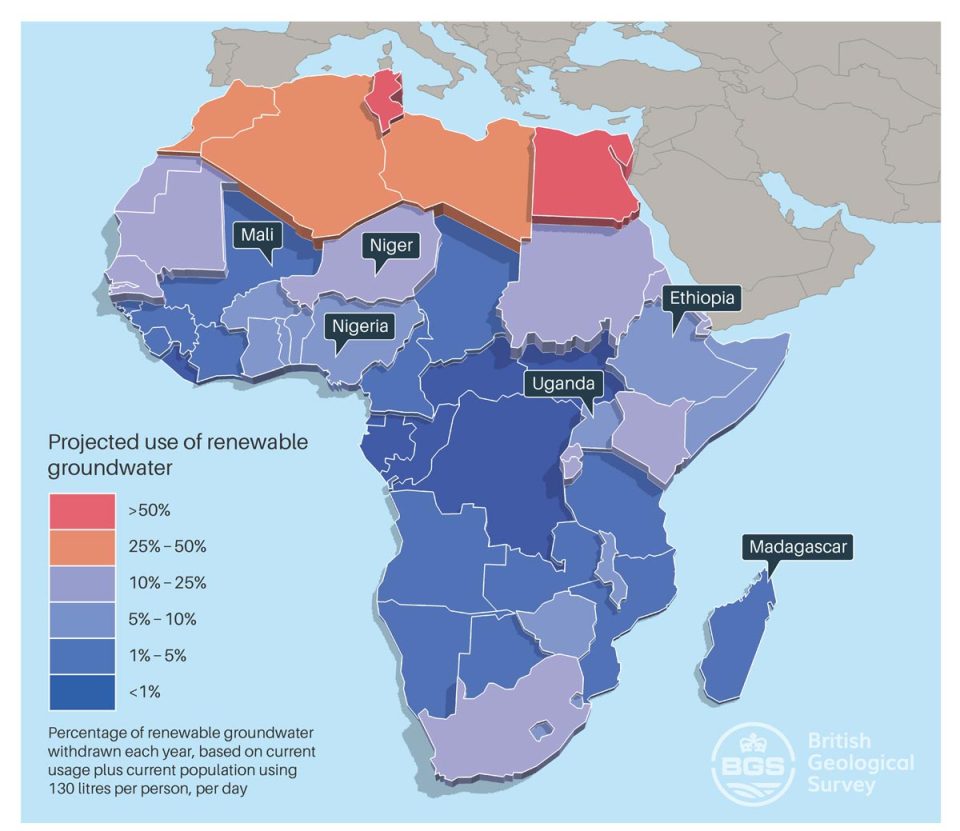BGS and WaterAid publish new research on groundwater resilience
Most African countries have enough groundwater reserves to face at least five years of drought, new research reveals
21/03/2022 By BGS Press
There is enough groundwater under the continent of Africa for most countries to survive at least five years of drought – and some, more than 50 years – according to research by WaterAid and the British Geological Survey (BGS) released today. But gross underinvestment in services to get the water out of the ground and to those who need it most and untapped or poorly managed resources means millions of people don’t have enough safe, clean water to meet their daily needs, let alone face the impacts of the climate crisis, WaterAid and BGS warn in a new report.
Groundwater: The world’s neglected defence against climate change is released by WaterAid and BGS today as Heads of State meet at the World Water Forum in Senegal, West Africa.

Years of reserves of potentially usable groundwater at a national level, based on current usage plus current population using 130 litres per person per day and assuming no active recharge. Source: BGS © UKRI
Groundwater – which exists almost everywhere underground, in gaps within soil, sand and rock – has the potential to save hundreds of thousands of lives and be the world’s insurance policy against climate change, the organisations assert.
It could help communities cope not only with slow onset impacts like drought and irregular rainfall, but also provide resilience to rapid onset impacts like floods by ensuring safe water is available for all, including in schools and hospitals, according to the report.
Our findings debunk the myth that Africa is running out of water. But the tragedy is that millions of people on the continent still do not have enough clean water to drink.
There are vast reserves of water right under people’s feet, many of which are replenished every year by rainfall and other surface water, but they can’t access it because services are chronically underfunded. Tapping into groundwater would ensure millions have access to safe, clean water no matter what the climate crisis throws at them.
Tim Wainwright, Chief Executive of WaterAid in the UK
WaterAid and BGS produced a series of maps which chart current access to drinking water across Africa and drought resilience based on potential useable groundwater at national level. It reveals:
- Most countries in Africa have sufficient groundwater for people to not only survive but thrive – in some cases for more than 50 years.
- This includes Ethiopia and Madagascar – where only around half the population have clean water close to home – and large parts of Mali, Niger and Nigeria.
- Every African country south of the Sahara could supply 130 litres of drinking water per capita per day from groundwater without using more than 25% of the long-term average recharge1, and most less than 10%. This means groundwater could provide a buffer against climate change for many years to come, even in the unlikely event that it doesn’t rain.
Groundwater is nature’s water reservoir, and a key resource to help the world adapt to climate change. It’s widely available, controlled by natural variation in geology, but is out of sight beneath our feet.
To unlock the great potential of groundwater, we need the right investment in expertise to map groundwater, drill sustainable wells and find ways to maintain and manage water resources and services.
Professor Alan MacDonald, BGS Groundwater Resilience Lead
Karimatu, 17, from Adamawa, Nigeria, who is featured in the report, wakes up at 6am every day to collect water from a nearby stream, making at least three trips before school. Karimatu would like to be a doctor but fetching water early in the mornings affects her schoolwork. “Getting a steady water supply will make me happy,” she told WaterAid.
The report also explains that while groundwater in sub-Saharan Africa is largely underused, in other parts of the world – mainly in south Asia – overuse is rife. This, along with a lack of regulation, insufficient expertise and investment, often leads to mismanagement, contamination and pollution – with potentially devastating consequences:
- In some areas, farming is responsible for up to 90 percent of all groundwater use. While crops flourish now, boreholes may run dry meaning crops will be affected later and people resort to drinking unsafe water to survive. For example, in Pakistan, 94% of pumped groundwater is for irrigation.
- In other regions, groundwater is naturally contaminated with arsenic and fluoride which can lead to illness or even death. For example, in India, arsenic contamination affects the northern states of Uttar Pradesh and Bihar, and West Bengal in the east. Several districts of Odisha are affected with high fluoride, iron and salinity and parts of central and Southeast India also show higher levels of nitrate and iron contamination.
- In both south Asia and Africa, groundwater is vulnerable to pollution whether it be from fertilisers and pesticides from intensive farming, toxic chemicals from poorly regulated industry or sewerage from poorly managed sanitation. For example, a recent survey of boreholes in Ethiopia, Uganda and Malawi saw E. coli present in the water from 20% of rural handpumps, likely as a result of poorly sealed boreholes, allowing contaminated water from nearby toilets to drain into the pump intakes.

Percentage of the population using, at least, basic drinking water services, JMP 2020. Source: BGS © UKRI
Groundwater: The world’s neglected defence against climate change emphasises the need to increase water and sanitation financing for marginalised communities through a fixed percentage of annual government budgets and increased international donor and private sector investment.
It also stresses the importance of agreeing at COP 27 that investment in responsible groundwater development and the knowledge, expertise, finance and institutional support this requires, is key to securing life-saving sustainable and safe water and sanitation for communities living on the frontline of the climate crisis.
One of the ways to achieve this is to invest in better mapping and monitoring of the Earth’s subsurface to determine where good-quality groundwater is not only available but also extractable in a sustainable and economical way, to unlock its full potential, WaterAid and BGS said.
WaterAid
WaterAid is working to make clean water, decent toilets and good hygiene normal for everyone, everywhere within a generation. The international not-for-profit organisation works in 28 countries to change the lives of the poorest and most marginalised people. Since 1981, WaterAid has reached 28 million people with clean water and nearly 29 million people with decent toilets. For more information, visit wateraid.org/uk or on Facebook, LinkedIn or Instagram.
- 771 million people in the world – one in ten – do not have clean water close to ho[1]
- 7 billion people in the world – more than one in five – do not have a decent toilet of their own.[2]
- Around 290,000 children under five die every year from diarrhoeal diseases caused by poor water and sanitation. That’s more than 800 children a day, or one child every two minutes.[3]
- Every £1 invested in water and toilets returns an average of £4 in increased productivity.[4]
- Just £15 can provide one person with clean water.[5]
Methodology:
A detailed methodology is included in the report Groundwater: The world’s neglected defence against climate change
References:
[1] WHO/UNICEF Joint Monitoring Programme (JMP) Progress on drinking water, sanitation and hygiene: 2017 update and SDG Baselines
[2] WHO/UNICEF Joint Monitoring Programme (JMP) Progress on drinking water, sanitation and hygiene: 2017 update and SDG Baselines
[3] Prüss-Ustün et al. (2014) and The Institute for Health Metrics and Evaluation (2018)
[4] World Health organization (2012) Global costs and benefits of drinking-water supply and sanitation interventions to reach the MDG target and universal coverage
Relative topics
Latest news

Goldilocks zones: ‘geological super regions’ set to drive annual £40 billion investment in jobs and economic growth
10/06/2025
Eight UK regions identified as ‘just right’ in terms of geological conditions to drive the country’s net zero energy ambitions.

What is the impact of drought on temperate soils?
22/05/2025
A new BGS review pulls together key information on the impact of drought on temperate soils and the further research needed to fully understand it.

Geology sans frontières
24/04/2025
Geology doesn’t stop at international borders, so BGS is working with neighbouring geological surveys and research institutes to solve common problems with the geology they share.

Presence of harmful chemicals found in water sources across southern Indian capital, study finds
10/03/2025
Research has revealed the urgent need for improved water quality in Bengaluru and other Indian cities.

Pioneering tool expanding to analyse agricultural pollution and support water-quality interventions
06/02/2025
An online tool that shows which roads are most likely to cause river pollution is being expanded to incorporate methods to assess pollution from agricultural areas.

Dynamics of land-to-lake transfers in the Lake Victoria Basin
09/12/2024
In June 2024, a UK/Kenya research team shared research findings from a collaborative, four-year field and experimental programme within Kenya.

The challenge of assessing the UK economy’s dependence on mineral supply
28/11/2024
Critical, essential, or just plain important? Dr Gavin Mudd, director of the Critical Minerals Intelligence Centre, discusses the findings and new methodology featured in the 2024 UK Criticality Assessment.

Brighid Ó Dochartaigh honoured with prestigious Geological Society award
27/11/2024
A recently retired BGS employee has been honoured for her contribution to the hydrogeological community.

Studying oxygen isotopes in sediments from Rutland Water Nature Reserve
20/11/2024
Chris Bengt visited Rutland Water as part of a project to determine human impact and environmental change in lake sediments.

UK–Philippine partnership to help tackle the challenges of future water security in the Philippines
07/11/2024
New ‘hydrological hub’ to foster research and provide essential national water management datasets and tools.

BGS Groundwater Flooding Susceptibility: helping mitigate one of the UK’s most costly hazards
25/09/2024
Groundwater flooding accounts for an estimated £530 million in damages per year; geoscientific data can help to minimise its impact.

Mining sand sustainably in The Gambia
17/09/2024
BGS geologists Tom Bide and Clive Mitchell travelled to The Gambia as part of our ongoing work aiming to reduce the impact of sand mining.





